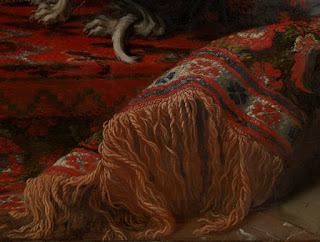 |
| Le Brun, Everhard Jabach and His Family (MMA 2014.250) |
In a letter to Jacobi a month later, Goethe writes: "Offt wohn ich mit Jappachs Geist." He seems to have been very impressed with what he saw at the Jabach house, as can be seen from his recollection in book 14 of Poetry and Truth of his visit to the house and of the Le Brun portrait of the Jabach family. This painting, long thought to have disappeared, turned up in a storeroom outside London in 2013 and was quickly acquired by the Metropolitan Museum of Art. It is now in the Charles Wrightsman collection of the European Paintings Galleries at the Met and has been given the title Everhard Jabach (1618–1695) and His Family. The Museum has just published a Bulletin discussing the painting and its conservation, and the opening essay by Stephan Wolohjian quotes Goethe's reaction, as recorded in his autobiography, to the Jabach house and the painting. Here is the quote from Poetry and Truth:
The former wealthy owner of this dwelling sat depicted there with his wife, surrounded by his children, all alive, fresh, and vivid, as if painted yesterday, indeed today, and yet they had all passed away. Even these fresh, round-cheeked children had grown old, and without this artistic representation not a memory of them would have remained. I find it difficult to describe my response to these impressions, so overwhelmed was I by them (translation from Robson-Scott, The Younger Goethe and the Visual Arts).
Everhard Jabach, from a very wealthy merchant family in Cologne, amassed a huge art collection, beginning his collecting activities as a young man traveling first in Flanders and the Netherlands and then in England, where he became acquainted with works by Leonardo, Raphael, Dürer, and Holbein. He was a friend of the artist Van Dyck, who executed two paintings of Jabach. After moving on to France, he continued to amass art while also embracing the world of commerce. In 1664, he was one of the first directors of the French East Indian Company and was installed by Colbert as director of the Aubusson tapestry workshop. Jabach also had a close relationship at this time with the painter Charles Le Brun.
 |
| Holbein the Younger, Study for Family Portrait of Thomas More |
The effect on Goethe of the Jabach house had much to do with the meeting with Jacobi in Cologne. The best account is the letter addressed to Jacobi mentioned above, written on August 21, 1774, a month after the meeting in Cologne. It is full of the rapturous sentiments of that time. For instance, this famous utterance:
Sieh lieber, was doch alles schreibens anfang und Ende ist die Reproduktion der Welt um mich, durch die innere Welt die alles packet, verbindet, neuschafft, knetet und in eigner Form, Manier, weider hinstellt, das bleibt ewig Geheimniss Gott sey Dank, das ich auch nicht offenbaaren will den Gaffern u. Schwäzzern (Der junge Goethe, letter 262).
Decades later, in Poetry and Truth, he still seems to be in touch with the feelings of that time. As he writes, Cologne was a place where the past could have an "incalculable effect" on him. That included the ruins of the cathedral, awakening sentiments similar to those in Strassburg, but the sight of which in Cologne plunged him into sadness when he considered that "this building of world importance had been abandoned in the midst of construction." It was at such a moment that he connects his visit to the Jabach house.
This family had evidently died out long ago, but we found nothing altered in the ground level, which opened into a garden. ... Everything was typical of those earlier days, and there was nothing new or modern in the whole room except ourselves. Our feelings, already strangely stirred by these things, were immensely heightened and culminated when we saw the large family portrait over the fireplace (Robert Heitner translation).
This is followed by the description of the painting mentioned above that is quoted in the Met's Bulletin. According to Wolohojian, there is only one other recorded instance of the painting before its rediscovery in the 21st century. In 1789, the painting was still in the same spot in Cologne, when, three weeks after the fall of the Bastille, it was viewed by Louis Joseph, Prince of Condé, who found it a "très grand tableau." It apparently made no further impression on the count, but Goethe, as he writes in his autobiography, was moved, with the result that "every good and loving force in my inner self must have opened up and gushed forth, because from that moment on, without further investigation and deliberation, those excellent men [the Jacobi brothers and Heinse] gave me their trust and affection for life."









